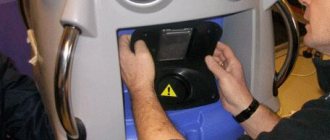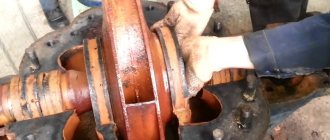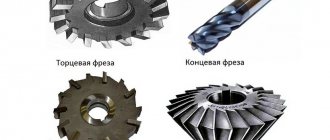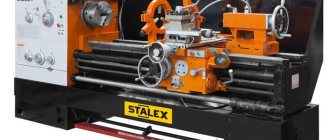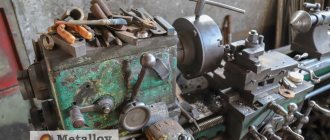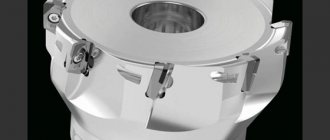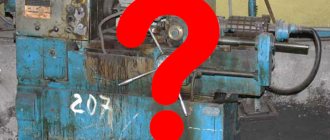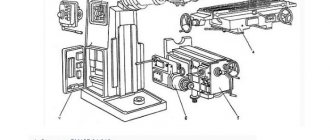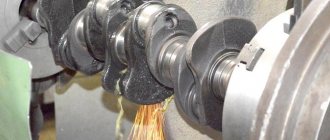Changing the oil in a lathe
The service life of turning equipment largely depends on the proper functioning of the lubrication system of the units, the surface of which is in constant friction against each other. Timely lubrication prolongs the serviceability of machines, reduces their power consumption, reduces the load on parts, and reduces their wear. In addition, the use of high-quality lubricants has a positive effect on the quality of turning, efficiency, and allows maintaining the temperature of the units in a given range. Factors such as the health of the system and the choice of suitable oil are decisive.
Lubrication systems for lathe components
The operation of lubricating devices that deliver oil to the required point is based on the simplest laws of physics:
- Gravity, allowing oil to flow to the friction point on its own
- Capillary forces, which, through porous bushings and wicks, lift the lubricant to a certain height.
- The viscous friction force generated between the surface and the lubricant material itself prevents the latter from flowing down.
- Pressure. Used in manual lubrication systems such as piston pumps and oilers.
- Centrifugal forces causing oil to flow under pressure to surfaces.
- Inertia. Due to the capture of liquid by the rotating elements of the machine, its particles are scattered.
- The pressure difference that creates self-suction of oil through the mechanisms themselves.
Methods for lubrication of a lathe
1. Periodic manual lubrication - performed through technological openings that are closed during operation of the machine. To perform this, a syringe or oil can is used. A piston hand pump is used to deliver fluid to hard-to-reach places.
2. Drip or wick method - produced using drip or wick oilers by filling special containers. Of the latter, lubricant is continuously supplied to the surface of parts due to capillary forces.
3. Circulating lubrication - produced through the operation of a hydraulic pump, which supplies oil under pressure directly to the parts. The liquid drains naturally. The amount of lubricant supplied is regulated by special devices.
4. Crankcase method - produced by spraying oil with a fast-moving impeller or a gear immersed in a lubricant, connected to rotating parts of the equipment.
5. Combined lubrication - used in cases where the listed methods separately cannot provide optimal lubrication of mechanisms and parts.
Oil in a lathe performs the following functions:
- Protects mechanisms and parts from wear;
- Removes wear products from the working area;
- Removes heat;
- Reduces friction coefficient.
Types of oils for metalworking machines
When servicing equipment for metal turning, so-called industrial oil is used - a distillate petroleum product with low or medium viscosity. Its characteristic conditions of use are moderate pressure and thermal conditions, and you can buy it from any manufacturer. The main thing is compliance with GOST.
High-quality industrial oil for lubrication of machine tools has the following characteristics:
- Does not form foam;
- Does not form persistent emulsions with wear products;
- Resistant to elevated temperatures;
- Has high dispersing and washing properties;
- It has a stable chemical composition.
For industrial oils, the defining characteristics are:
- Density - has a greater effect on the properties of oils for hydraulic systems. Transmitting qualities decrease as the density of the liquid decreases.
- Viscosity is a parameter that directly affects the quality of the lubricant. It is the most important when choosing a lubricant for turning equipment. Depends on operating conditions, in particular on temperature. The higher the last indicator, the lower the viscosity.
- Flash point – affects oil consumption and waste. Essentially it is the ignition temperature of a liquid.
- Pour point – taken into account when storing liquid and transferring it.
- Ash content – degree of purification. The lower this indicator, the better the oil is purified.
- Acid number and sulfur content - the degree of purification from acids and sulfur.
To be sure which oil to pour into a particular lathe, its choice is made based on the manufacturer’s recommendations, which are necessarily indicated in the operating instructions.
Industrial oils for lubrication of lathes and drilling machines are divided into:
- And - without additives;
- IGP (alloyed) – with additives.
The following brands of industrial oils without additives are poured into the lathe:
- I-5A - used for lubricating mechanisms and components operating at high speed under light load, which do not require special anti-oxidation and anti-corrosion properties of the lubricant composition. At 40°C it has a kinetic viscosity of 6-8 mm2/s and a flash point of 120°C. In metal-cutting machines it is used to lubricate high-speed spindle units. Can be replaced with brands I-8A, ILS-5.
- I-8A is a similar brand to the previous one. At 40°C they have a kinetic viscosity of 9-11 mm2/s and ignite from 130°C. Can be replaced with brands I-5A, ILS-10, ILS-5.
- I-20A - used for lubrication of components operating at lower speeds and high loads, for example, sliding and rolling guides, gears. Viscosity 29-35 mm2/s and flash point from 180°C. Can be replaced with IGP-18 brand or another similar viscosity index.
- I-30A - in turning equipment it is mainly used for lubrication of the apron, drive shafts, slides, tool holder, and replaceable gears. Viscosity is 41-51 mm2/s and ignition occurs at 200°C. Can be replaced with brand IGP-30 or similar in viscosity.
- I-40A – Used for lubrication of gears. Viscosity 61-75 mm2/s and flash point from 200°C. Can be replaced with brand IGP-38 or similar in viscosity.
- I-50A - viscosity 90-110 mm2/s and flash point from 215°C. Can be replaced with brand IGP-38 or similar in viscosity.
1. Maintenance of the machine’s lubrication system by a turner consists of daily checking the oil level in the reservoir before starting turning work. If necessary, add liquid. When replacing, drainage is carried out through the plug. Before filling the tank, the latter is cleaned and washed with kerosene.
2. The apron mechanism has an automatic lubrication system with an individual pump. The oil level being filled is controlled by an oil indicator, usually located on the front side. The cross slide and carriage are lubricated at the beginning and middle of the shift until an oil film appears on the guides. Lubrication of the lead screw support bushings and guides during screw cutting operations is carried out with the uterine nut on.
3. The tailstock, lead screw and shaft supports are lubricated with wicks from the reservoirs. In the latter, oil must be poured until it flows out. Lubrication of the tapered axis of the tool holder is carried out daily at the end of the shift. In this case, the cutting head is removed.
4. All other points, with the exception of the replacement gears and the idler gear shaft, are lubricated manually with an oil can, which should be supplied with the machine.
5. To ensure long-term operation of the machine and turning accuracy, the turner constantly monitors the lubrication of rubbing parts. All oil holes, oil nipples and pipes that supply oil to lubrication points must be clean and capped.
Industrial oil is not a cutting fluid. Therefore, its use for lubricating cutting tools is unacceptable. For this purpose, a special coolant is used - an emulsion lubricating composition based on water and oil with various extreme pressure and anti-wear additives.
How to choose lathe lubrication oil
As a rule, industrial oil is used in the maintenance of turning equipment. It is available for sale everywhere (it is only important to choose an option that complies with GOST), they work under conditions of moderate temperature and pressure. During operation it does not foam, does not form an emulsion with wear products (dust, shavings). It has excellent washing and dispersing characteristics, as well as a fairly stable chemical composition.
What characteristics do you pay attention to when choosing the type of industrial oil:
- Density. The lower it is, the lower the transmitting qualities of the lubricant will be.
- Viscosity. One of the main quality parameters – perhaps even the most important. Viscosity strongly depends on operating conditions, especially temperature.
- Pour point. It is important to know this parameter for proper storage and transportation of the composition.
- Ignition (flash) temperature - this indicator affects the release of carbon monoxide, as well as lubricant consumption.
- Percentage of sulfur and acid.
- Degree of purification from foreign impurities and evils.
- Without additives (I) or with additives (IGP, alloyed).
Let's take gear transmissions as an example - oil with medium viscosity is suitable for them. While guides with low movement speed require increased viscosity of the product.
The manufacturer of any machine indicates in the instructions which lubricant is best to use. Therefore, the best solution is to follow his recommendations.
Wood and metal processing
A gear pump, driven from the main drive electric motor through a belt drive, sucks oil from reservoir 18 and supplies it through a strainer to the spindle bearings and oil distribution trays. About a minute after turning on the electric motor, the oil indicator disk begins to rotate. Its constant rotation indicates normal operation of the lubrication system.
The oil is drained from the spindle head and feed box through a strainer with a magnetic liner into the reservoir. During operation, monitor the rotation of the oil indicator disk. When it stops, immediately turn off the machine and clean the filter. To do this, remove it from the tank body, having previously disconnected the pipes, unscrew the nut located at the bottom, and remove the filter mesh elements in the plastic mandrel. Each element is washed in kerosene for complete purification. Do not blow out the filter elements with compressed air, as this may damage the fine mesh. After cleaning, the filter is assembled, installed in the tank and pipes are connected.
In a new machine, the filter is cleaned at least twice a week for the first two weeks, and then once a month.
To clean a filter with a magnetic insert, remove it from the tank, remove the lid, remove the magnetic insert from the glass and wash all surfaces in kerosene. The filter is cleaned once a month. Filters must be cleaned before and after each oil change.
Every day before starting work, check the oil level in the tank using the indicator and, if necessary, add it through the hole in the drain line. When replacing, the oil is drained from the reservoir through the plug. Before adding fresh oil, the tank is cleaned and washed with kerosene. The lubrication of the apron mechanism is also automatic, but is carried out by an individual plunger pump. Oil is poured into the housing through a hole closed by a plug, and drained through the hole. The oil level is controlled using the oil indicator. The guides of the carriage and cross slide are lubricated at the beginning and in the middle of the shift, alternately stirring the carriage and cross slide at high speed until an oil film appears on the guides. When screw-cutting work, the guides, as well as the lead screw support bushings located in the apron, are lubricated in the manner described above with the split nut turned off by the handle.
The supports of the lead shaft and lead screw and tailstock are lubricated with wicks from reservoirs into which oil is poured through holes closed with caps. The tailstock reservoir is filled until oil flows out through the hole (indicator). The replacement gears and the intermediate replacement gear axle are lubricated by hand with grease.
The remaining points are lubricated manually using an oil can.
The first oil change is 1 month after putting the machine into operation, the second is 3 months later, and then strictly following the instructions of the lubrication chart.
Lathe design, maintenance and lubrication
Lathe lubrication
Lathe lubrication
Next: Basic rules for caring for a lathe
A gear pump, driven from the main drive electric motor through a belt drive, sucks oil from reservoir 18 and supplies it through a strainer to the spindle bearings and oil distribution trays. About a minute after turning on the electric motor, the oil indicator disk begins to rotate. Its constant rotation indicates normal operation of the lubrication system.
The oil is drained from the spindle head and feed box through a strainer with a magnetic liner into the reservoir. During operation, monitor the rotation of the oil indicator disk. When it stops, immediately turn off the machine and clean the filter. To do this, remove it from the tank body, having previously disconnected the pipes, unscrew the nut located at the bottom, and remove the filter mesh elements in the plastic mandrel. Each element is washed in kerosene for complete purification. Do not blow out the filter elements with compressed air, as this may damage the fine mesh. After cleaning, the filter is assembled, installed in the tank and pipes are connected.
In a new machine, the filter is cleaned at least twice a week for the first two weeks, and then once a month.
To clean a filter with a magnetic insert, remove it from the tank, remove the lid, remove the magnetic insert from the glass and wash all surfaces in kerosene. The filter is cleaned once a month. Filters must be cleaned before and after each oil change.
Every day before starting work, check the oil level in the tank using the indicator and, if necessary, add it through the hole in the drain line. When replacing, the oil is drained from the reservoir through the plug. Before adding fresh oil, the tank is cleaned and washed with kerosene. The lubrication of the apron mechanism is also automatic, but is carried out by an individual plunger pump. Oil is poured into the housing through a hole closed by a plug, and drained through the hole. The oil level is controlled using the oil indicator. The guides of the carriage and cross slide are lubricated at the beginning and in the middle of the shift, alternately stirring the carriage and cross slide at high speed until an oil film appears on the guides. When screw-cutting work, the guides, as well as the lead screw support bushings located in the apron, are lubricated in the manner described above with the split nut turned off by the handle.
The supports of the lead shaft and lead screw and tailstock are lubricated with wicks from reservoirs into which oil is poured through holes closed with caps. The tailstock reservoir is filled until oil flows out through the hole (indicator). The replacement gears and the intermediate replacement gear axle are lubricated by hand with grease.
1. LUBRICATION DIAGRAM of the 16k20 machine: 1, 7 - oil indicator, 2 - guide lubrication spool button, 3,14, 15 - manual lubrication points, 4, 16 - oil level indicator, 5, b, 10. 17 - holes for oil filling , 8, 19 - drain holes, 9 individual plunger pump, 11. 13 - strainer, 12 - gear pump, 18 - reservoir
The remaining points are lubricated manually using an oil can.
The first oil change is 1 month after putting the machine into operation, the second is 3 months later, and then strictly following the instructions of the lubrication chart.
Maintenance of screw-cutting lathes
Screw-cutting lathes are used in various industries, most often they can be found in machine-building industries. Any work must be done with high quality, but details on which human life and health may depend must be done with special filigree, which can only be done on a perfectly adjusted, properly functioning machine. In order for it to serve for a long time, and for the threaded parts to meet their intended purpose, it is necessary to properly maintain the turning equipment.
Information about the manufacturer of the screw-cutting lathe 16K20
The first universal screw-cutting lathes with a gearbox for the first time in the USSR began to be produced at the Moscow Machine Tool Building named after. A.I. Efremov in 1932 and received the names DIP-200, DIP-300, DIP-400, DIP-500 ( DIP
- Catch up and Overtake), where 200, 300, 400, 500 is the height of the centers above the frame.
Machine tools produced by the Moscow Machine Tool Plant Krasny Proletary, KP
History of the series of screw-cutting lathes from DIP-200 → 1a62 → 1k62 → 16k20 → MK6056
In 1930, the Moscow Machine Tool Plant decided to develop a new standard lathe, abbreviated as TS. Somewhat later it was renamed DIP-200 - Let's Catch Up and Overtake
, according to the main slogan of the first five-year plan, where 200 is the height of the centers above the frame.
from the German company VDF was chosen as a prototype .
In April 1932, preparations began for the release of the first batch of DIP-200 machines. On April 25, 1932 , the first Soviet universal screw-cutting lathe with a gearbox, DIP-200, was assembled and tested. By the end of 1932, 25 DIPs were produced.
In 1934, production of machines DIP-300, DIP-400, DIP-500 was mastered. Subsequently, the production of these machines was transferred to the Ryazan Machine Tool Plant. The production of the DIP-500 machine was also transferred to the Kolomna Heavy Machine Tools Plant KZTS.
In 1937, ENIMS developed a type (nomenclature of types and sizes) of machine tools and adopted a unified system of machine symbols. According to the new designation system, the first DIP-200 became known as 1D62
. But the abbreviation DIP-200 has been preserved to this day - to designate a lathe with a center height above the bed equal to or close to 200 mm.
In 1940, the plant produced the 162K (26A) machine - one of the DIP-200 variants.
Daily care
The most reliable care for a lathe is to prevent damage to it. Preparation for the next work shift should be carried out immediately after finishing work and disconnecting the machine from the power supply. At this stage of maintenance, the following operations are performed:
- Chips and other technical debris are swept away from the surface.
- It is necessary to dissolve oil and dirt with kerosene and wipe dry with a rag.
- To avoid corrosion, all parts that do not have a paint coating are lubricated with oil.
- The oil cans are filled with grease.
Before starting a shift, it is necessary to check the presence of lubricant and inspect the equipment for damage or loose parts. During work, it is necessary to observe safety precautions when working with turning mechanisms - this will minimize injuries in the workplace and reduce the risk of equipment breakdown. During work you must:
- The use of protective screens, which will avoid clogging the lathe with metal shavings and small abrasive particles that arise during processing of the part.
- Timely replacement of drilling and cutting parts.
- Control over the reliability of fastenings of cutters and drills.
- During operation, do not allow the formation of long chips, which, if wound around the rotating parts, can damage the mechanism.
- You can turn on the machine only after the cutter is lowered onto the blank, in the place specified in the drawing.
Video covering basic maintenance principles.
General rules for caring for machines
Basic rules for caring for the machine before starting work:
- check the lubrication and cooling systems, the tension of the drive belts, the reliability of the tightening of the clamping elements, the serviceability of the control mechanisms, tools, auxiliary devices, protective guards, grounding and grounding devices;
- lubricate rubbing pairs that do not have a centralized oil supply;
- remove foreign objects from the work area.
Caring for the machine after the end of the shift:
- put tools, equipment, finished products and workpieces in the places designated for their storage;
- remove chips and dirt from surfaces and grooves;
- apply lubricant to the guides (the rules for caring for a lathe also include lubricating the quill, lead screw, tailstock screw, and lead roller with bearings).
How does the machine lubricate automatically?
Lubrication of a screw-cutting lathe, or rather its moving parts, must occur constantly during operation. The supply of lubricants to the rotor is indicated by the rotating disk on the spindle head. Its rotation should begin within a minute after starting the equipment. This time should be enough for the gear pump, connected by a belt drive to the main engine of the unit, to supply oil to the reservoir. The lubricant will reach the engine bearings and oil distribution trays through a strainer with a magnetic liner. The system is closed - flowing into the spindle head, the oil again enters the reservoir, where it is cleaned of debris by a filter and again ends up on the moving parts.
Intermittent movement or stopping of the disk indicating the flow of lubricant to the parts of the screw-cutting lathe indicates that the filter is clogged or there is not enough lubricant in the system. In this case, the machine must
- disable,
- cut off the power
- remove the filter,
- wash it with kerosene,
- check the lubricant level in the reservoir,
- add oil if necessary,
- insert the filter into place and start the unit.
How to remove the filter
The mesh filter consists of several elements. To get it out of the tank, which serves as the filter housing, you need to disconnect the hoses from it, unscrew the bottom nut, and remove the filters along with the plastic frame.
Attention! Filters can only be washed in kerosene. Under no circumstances should they be cleaned with air. This method of cleaning can lead to the immediate loss of the mesh’s working qualities. Strong air pressure deforms its cells.
Scheduled maintenance with mandatory filter washing is carried out in accordance with the instructions in the technical data sheet of the equipment.
Lubrication of a screw-cutting lathe during maintenance
Mineral oils are used to lubricate the lathe, and solid oils are used for bearings. The lower the load and the higher the rotation speed, the less thick the lubricant should be. The required brand of lubricant is set by equipment manufacturers in accordance with the temperature to which the mechanism heats up during operation.
An example of a lubrication schedule and the choice of oil depending on the unit
In order not to make a mistake, it is necessary for each individual mechanism to determine the admissibility of using a certain type of solid oil in accordance with the technical data sheet.
For lathes, 4 methods of lubrication of units are applicable:
- Circulation method - oil is supplied under the influence of a pressure pump, which forces the oil under pressure to circulate through a system of tubes leading to the units.
- Wick is one of the simplest and most reliable. In a lathe it is an addition to the crankcase option in case there is concern that the oil may not reach its target. A wick is inserted into the tube; it should be 6-8 mm from the surface onto which oil should fall at a certain frequency.
- Manual - in this method, lubricant is applied to bearings, carriage, screw and other open rubbing parts. Oil is poured into oil cans, and solid oil is injected into them using a syringe. This type of maintenance is carried out daily. If the machine is used intensively, it may require more frequent lubrication.
- The crankcase method is used to lubricate the gearbox, feed box and apron worm gear. The method is that oil is sprayed from a reservoir filled to a certain level by rotating gears. To monitor the oil level, there are control eyes and a tubular oil level indicator.
It is necessary to remember not only about the constant replenishment of lubricant reservoirs, but also that once a month it will need to be completely replaced. Before pouring a new portion of lubricant into the oil cans, it is necessary to remove the filters and gears from the tanks, and remove the wicks from the tubes. All this equipment must be washed and cleaned.
For the greatest effect, screw-cutting lathes often use all 4 types of lubricants at once, which makes it possible not to miss any of the components. Provided that technical equipment receives proper maintenance, its service life is significantly increased.
General view of the screw-cutting lathe 16K20
Photo of a screw-cutting lathe 16k20
Photo of a screw-cutting lathe 16k20
Photo of a screw-cutting lathe 16k20
Scheduled preventive maintenance - PPR
Scheduled preventive maintenance is a set of measures to maintain the machine in working condition while maintaining its technical characteristics at the level corresponding to those specified by the manufacturer in the machine’s passport.
In accordance with the maintenance schedule drawn up based on the operating mode of the unit, the following is carried out:
- Maintenance – cleaning, lubrication, filling and changing oils.
- Replacement of worn parts and dull cutters.
- Washing the entire machine or its individual components.
The preventive maintenance plan should include:
- preventative repairs;
- current (small and medium) PPR;
- capital PPR.
Between-repair maintenance
Compliance with the operating requirements stated by the manufacturer refers to:
- equipment control mechanisms;
- workplace barriers;
- maintaining lubricating devices and reservoirs clean, monitoring their filling with lubricants.
- troubleshooting minor problems;
- adjustment of adjustable mechanisms.
All of the listed types of maintenance do not require much time, which allows them to be carried out during technological, lunch, and inter-shift breaks. It is better to schedule equipment readjustment on weekends. For high-level turners with permission to carry out a certain type of adjustment work, this will not be difficult. In other cases, it is necessary to add this type of minor repair to the to-do list for the workshop repair and commissioning team.
PPR of automatic machines is carried out daily, after the end of the shift. When the workshop operates in 2 and 3 shifts, they are serviced once every 8 hours. In workshops with a shift work schedule, there must be a repair and adjustment service consisting of:
- mechanics;
- lubricants;
- locksmiths;
- electricians;
- saddlers and other specialists of a narrow profile.
This should ensure high quality of each unit individually, and the machine as a whole.
Equipment maintenance records
In every workshop equipped with machines, a maintenance log must be kept. At the end of each shift, workers must leave notes in it about the serviceability or malfunction of the machine, indicating defects, breakdowns, the need for any unscheduled work, or complaints about the operation of a certain unit or mechanism.
After inspection and carrying out the necessary list of work, the adjuster also submits a report on the work done, indicating the breakdown and a list of repair actions performed.
Washing of machines is carried out according to a schedule drawn up by a mechanic, in accordance with the manufacturer’s recommendations in conjunction with the operating mode of the machine.
Geometric rigidity testing is based on GOST requirements. It is carried out after work of medium complexity or major repairs. The basis for this check is the schedule drawn up by the mechanic for carrying out maintenance work. The list of machines subject to this inspection is compiled by the chief production technologist.
Areas of use of turning equipment
Screw-cutting lathes vary in weight and size, which directly depends on the industry where they are used. They can produce short and long, thin and wide parts. These lathes can cut internal and external threads on parts. The heavier the part, the more massive the machine for processing it.
Light weight turning equipment is used:
- in experimental workshops;
- in instrument making;
- in the manufacture of watch movement parts.
This type may have a mechanical supply of blanks to the cutter, which allows for faster production of identical parts, if necessary, to produce them in small batches. For the production of piece products, this mechanism is not required, which will be reflected in the design of the lathe.
In the industrial production of threaded parts and tools, medium-weight machines are more often used. Their design contains many automatic systems, which, along with rotary mechanical parts, require preventive checks and debugging. Moving, twisting, rotating, cutting and drilling parts require regular lubrication.
Heavy weight turning equipment is used for more repetitive operations. On it are machined:
- shafts;
- turbines;
- wheels for trains.
Despite the small range of products and a small selection of operations, these machines cannot be called simple. There are also many components in its design that require constant care and monitoring. Lubrication and cleaning of parts becomes more difficult due to their heavy weight.
Types of machine maintenance
According to GOST 18322, machine maintenance is divided into the following types:
In production, equipment maintenance is usually divided into:
routine (cleaning and lubrication of externally accessible components and mechanisms, control of heating of rubbing parts, etc.), which is the responsibility of the machine operator;
scheduled (cleaning and lubrication of components and mechanisms that require disassembly, changing oil and filters, adjustment, adjustment) - it is performed by the mechanic service.
Solid lubricants
Solid or plastic lubricants are formed by mixing mineral liquid oils with special thickeners. The composition of the thickener determines the properties of the lubricant. Calcium, lithium, sodium lubricants, so-called solid oils, lithols, etc., are common.
Plastic lubricant material reduces friction in bearings of components and mechanisms. The lubricant must remain stable under the influence of high temperatures, mechanical pressure, and prevent the ingress of water and abrasive particles. When mechanisms are not in operation, when there are no heavy loads or high temperatures, grease acts as a preservative, protecting the metal from corrosion.
Frequency and rules of maintenance, selection of oil and lubricant for metal-cutting machines
The main document defining the rules of care and frequency of maintenance is the machine passport. The points to be lubricated, the type and amount of lubricant for each of them are indicated in the lubrication card and table.
If operating conditions require changing the intervals between maintenance and/or using lubricants of other brands, the company’s chief mechanic service draws up its own maintenance cards.
Oils for metal-cutting machines must have high washing ability - small metal shavings and dust generated during the processing of workpieces accelerate the wear of rubbing pairs. Their viscosity is selected taking into account the speed of operation and the degree of load of the mechanisms.
Machine oils of the brands ZIC, Mobil, Mannol have excellent performance characteristics.
Oil coolants form a film that is difficult to remove on the surfaces of machine tools. The use of synthetic compounds reduces the time spent on equipment maintenance.
Oil selection
If it is not possible to find out the type of oil specified in the machine’s passport, then the lubricating fluid is selected taking into account the type of equipment, its location and installation method, the material of the rubbing surfaces, and the operating temperature range. Thus, horizontal and vertical sliding guides are lubricated with anti-jump material of 68 and 220 ISO viscosity grades, respectively. To lubricate linear guides, a liquid is used, selected taking into account the design features of the machine, the speed of movement of moving parts, and specific work loads. Particularly loaded components and mechanisms require lubrication with high-viscosity extreme pressure oils, while high-speed ones require lubrication with low-viscosity fluids with improved anti-friction properties. You can select the appropriate oil for any machine in the catalog of ROLF Lubricants GmbH.
Maintenance of lathes
The lubrication system of a lathe is not simple: many friction pairs operate at different loads and speeds, and therefore require the use of different lubricants and methods of supply.
What kind of oil should I pour into the lathe and what should I use to lubricate the guides? Industrial oil I-20A flows into the oil tank, I-30A into the feed box and apron, and I-12A into the spindle head. To lubricate the guides, it is recommended to use oils with anti-jump additives.
During daily maintenance of the lathe, the oil level should be checked at all sight eyes and topped up if necessary.
Care of lathes
Systematic maintenance of the machine, its adjustment and inspection are one of the most important conditions for the correct operation of the mechanism. After each shift, the machine must be cleaned, accumulated chips removed, and surfaces treated with an anti-corrosion compound. Rags and rags are usually used for cleaning. It is recommended to moisten the ends of the cotton cloth in kerosene and treat the guides of the frame and calipers with a moistened rag.
Another important maintenance rule is lubrication of the lathe, which helps protect working units from vibration and friction and prevent contaminant particles from entering the mechanism. A guide to lubrication is the machine's lubrication diagram, which indicates which components require maintenance and how often they need to be lubricated. In addition, the manual provides recommendations for lubricant selection. For lathes, industrial oil and grease are usually used, which is placed in the bearings of the mechanism. Bearing lubrication must be approached with extreme care. If grease is used as a lubricant, it is placed in special grease caps. Many modern machines use a special electric pump to lubricate the spindle bearing and friction clutch.
It is very important that lubricants do not clog other parts of the mechanism or get on the drive belts. The belt tension should be optimal, not too tight and not too loose. Correct adjustment of the belt will ensure normal conditions for the functioning of the bearings and prevent belt slippage.
Specifics of maintenance of CNC machines
In addition to general care rules, daily maintenance of computer-controlled machines includes:
thorough cleaning of the read heads;
checking the serviceability of pneumatic and hydraulic systems, CNC devices;
monitoring the condition of the most vulnerable parts and assemblies;
adjusting the accuracy of operations.
During routine maintenance of CNC machines, special attention is paid to cleaning dust from the electronic and electrical parts of the equipment - dust jumpers can lead to current leaks, reducing the accuracy of its operation, and short circuits on boards.
How to lubricate a CNC machine in the absence of lubricants recommended by the equipment manufacturer is decided by the chief mechanic’s service.
The most commonly used oils for CNC machines: for lightly loaded high-speed mechanisms - I-5A, I-8A, as the speed decreases and the load increases - I-12A, I-20A, I-30A, I-40A, I-50A.
Modern lathes
Lathes began to be used for cutting metal back in the 18th century. From that time on, their design began to become more complex: mechanized calipers and replaceable gears appeared. Modern lathes are complex automated devices, many of which use a special control device - CNC (Computer Numerical Control). CNC machines are classified as follows:
Using lathes, parts such as disks, flanges, rings, bushings are made, holes are bored, drilled, and threaded.
Features of maintenance of other types of machines
Milling
When maintaining a vertical milling machine, you need to monitor the oil level in the circulation system and hydraulic system, and refill the oil nipples of the guide slide, table, milling head, and table lifting and moving screws two to three times a shift.
Laser
Maintenance of a laser machine consists not only of timely lubrication of rubbing pairs. In addition, you need:
Before starting work, check whether the laser tube is completely filled with water, clean the reflectors and focusing lens from dirt, and check the optical trajectory;
clean the linear guides and chiller every two weeks, change the water;
If air pumping deteriorates, clean the corrugations and the hood from dust from the inside.
Bending
Gear or transmission oil with anti-corrosion additives is poured into bending machines, the viscosity of which depends on the ambient temperature. For example:
Bending machines installed outdoors require seasonal maintenance with the replacement of “summer” oil with “winter” oil or vice versa.
Before adding new oil to the bending machine, the tank and lines must be thoroughly cleaned.
Format-cutting
Maintenance of a formatting saw, like any other woodworking equipment, involves regular care of its external and internal surfaces - sawdust and dust accumulating on them are fire and explosion hazards.
When choosing what to lubricate the saw, give preference to compounds that prevent resin, dust, and shavings from adhering to the metal.
Drilling
During maintenance of the drilling machine, it is necessary to ensure that no lubricant gets on the contact surfaces of the spindle and chuck - this can lead to an accident.
Grinding
During daily maintenance of the grinding machine, it is necessary to thoroughly clean its surfaces from abrasive dust and remove sludge from the coolant settling tank, during routine maintenance, monitor the condition of the fine oil filter, and clean the tank and magnetic separator at least once every three months.
Rocking machine
Maintenance of the pumping machine is carried out twice a year in order to prepare for work in the autumn-winter and spring-summer periods, combined with scheduled repairs.
Maintenance rules
According to GOST 18322, there are several types of maintenance of machines, including maintenance when used for their intended purpose, during transportation, storage, on site or outside its territory, in stationary and special conditions, etc. When determining the frequency of maintenance and the amount of necessary work, they are guided first just the equipment passport. The same document indicates the lubrication scheme and type of oil. If the machine is operated under increased loads, the mechanic service can develop its own maintenance map. Small metal shavings and dust, which are formed during the processing of workpieces, accelerate the wear of friction pairs. Therefore, oil for this type of equipment must not only form a protective film on the surfaces being washed, but also have high cleaning properties. Lubricants that are well suited for use in machine tools can be selected from the Rolf product range.
Common types of maintenance
In general, in production, maintenance is usually divided into:
- to the current one, the execution of which is carried out by the operator. During this maintenance, all accessible components are cleaned and lubricated, the degree of heating of the rubbing elements is checked;
- planned, the implementation of which is assigned to the mechanical service. In this case, components that require disassembly are cleaned and lubricated, oils and filters are changed, and if necessary, adjustments and adjustments are made to the mechanisms.
Lathes
The peculiarity of lathes is the large number of friction pairs that operate under unequal conditions - with different loads and rotation speeds. Each of these pairs requires a different type of oil and a separate method of delivery. So, lubricant with viscosity class 22, 32, and 15, respectively, is poured into the oil tank, feed box and apron, spindle head. The guides are lubricated with materials with anti-jump additives.
CNC machines
During maintenance of CNC machines, general maintenance measures are performed, as well as:
- clean the read heads;
- check the serviceability of pneumatic and hydraulic systems, control devices;
- determine the condition of the most vulnerable components;
- if necessary, regulate the accuracy of the operations performed.
Milling machines
When performing maintenance on such a machine, you need to check the oil level in the circulation and hydraulic systems. During the operation of this equipment, the oil nipples of the guide slides, milling head, and table lifting and moving screws are refilled 2–3 times per shift.
Laser machines
Maintenance of a machine that performs cutting using a laser includes:
- checking the condition of the laser tube, cleaning the reflectors and focusing lens from dirt, monitoring the optical trajectory;
- maintenance of linear guides and chiller, i.e. cleaning them once every two weeks;
- if air extraction has deteriorated, remove dust from the corrugation.
Lubricant selection for guides
The best lubricant for guides is the one indicated in the equipment data sheet. If it is lost, you should choose what to lubricate the machine guides with, taking into account:
location in space;
material of rubbing surfaces;
operating temperature range.
To lubricate the horizontal sliding guides, anti-slip oils of ISO viscosity class 68 are used, and for vertical sliding guides, viscosity class 220 is used.
Which lubricant is best for rolling guides depends on the speed of operation and the degree of load - the lower the speed and the higher the load, the more viscous and dense the lubricant should be.
When deciding how to lubricate the linear guides of a machine, it is necessary to take into account the features of their design, movement speed, and specific workloads. Heavily loaded mechanisms require the use of high-viscosity extreme pressure lubricants, while high-speed ones require low-viscosity oils with improved anti-friction properties.
Mobil Vactra Oil series oils greatly facilitate the selection of lubricants for guides: they are suitable for any combination of materials of rubbing pairs.
Spindle oil (spindle): GOST 20799-88 and 1642-75
The main advantage of the spindle is that it retains its performance properties in the temperature range from -35°C to +100°C.
Spindle oils of grade A, which are produced in accordance with GOST 20799-88, are used as lubricants and hydraulic fluids for machines and mechanisms operating with low and medium loads, under gentle conditions (at operating temperatures up to +60°C, no contact with aggressive environments). The scope of their application is easy to determine if you use the appropriate designation according to GOST 17479.4-87:
| Oil brand | Designation according to GOST 17479.4 | Application options | |
| I-5A I-8A | I-L-A-7 I-L-A-10 | Lubricant for lightly loaded components and mechanisms with a rotation speed of 15-35 thousand rpm (bearings, spindle bushings, etc.). | |
| I-12A | I-LG-A-15 | Lubricant for lightly loaded components and mechanisms: bearings, spindle bushings, etc. with a rotation speed of up to 5 thousand rpm. Working fluid for volumetric hydraulic drives of machine tools, road construction equipment at temperatures down to -5°C. | |
| I-12A1 | I-LG-A-15 | Lubricant for lightly loaded components and mechanisms: bearings, spindle bushings, etc. with a rotation speed of up to 5 thousand rpm. Working fluid for lightly loaded volumetric hydraulic drives of machine tools, road construction equipment at temperatures down to -20°C. | |
| I-20A | I-G-A-32 | Working fluid for light and medium-load hydraulic systems of metal-cutting machines, forging and pressing equipment, automatic lines, construction and road machines at temperatures down to -5°C. Lubricant for light and medium-loaded gears, rolling and sliding guides of machine equipment. | |
| I-ZOA | I-G-A-46 | Working fluid for hydraulic systems of light and medium-load metal-cutting machines, forging and pressing equipment, automatic lines, construction and road machines at temperatures down to -5°C. Lubricant for lightly and moderately loaded gears, rolling and sliding guides. | |
| I-40A | I-G-A-68 | Working fluid for medium-load hydraulic systems of metal-cutting machines, forging and pressing equipment, automatic lines, construction and road machines at temperatures down to -5°C. Lubricant for lightly and moderately loaded gears, rolling and sliding guides. | |
| I-50A | I-GT-A-100 | Working fluid for hydraulic systems of heavily loaded machine tools, construction and road vehicles at temperatures down to -5°C. Lubricant for low-speed, heavily loaded machines and mechanisms. | |
For use in hydraulic systems of road and construction equipment and other special purposes, an alloyed spindle of the AU brand is used, the composition and technical characteristics of which are regulated by OST 38.01412-86 (valid instead of the canceled GOST 1642-75). Thanks to deep dewaxing, it does not harden at temperatures down to -45C.
Replacing coolant and flushing the system
To ensure that fresh coolant has a long service life, it is recommended to pour a system cleaner, such as OILCOOL XR, into the reservoir before the last start of the machine. It effectively dissolves dirt and deposits on surfaces. After 8 - 24 hours, it is necessary to drain all liquid from the system and rinse it with water.
The system cleaner completely removes the remnants of the old emulsion, so after flushing with its use, it is possible to fill the machine with a different brand of coolant.
In conclusion of the article, we suggest watching a video tutorial about the rules of maintenance of a lathe:

